SNAB TOPIC 8-Grey matter
1/24
There's no tags or description
Looks like no tags are added yet.
Name | Mastery | Learn | Test | Matching | Spaced |
|---|
No study sessions yet.
25 Terms
8.1 Know the structure and function of sensory, relay and motor neurones including the role of Schwann cells and myelination.
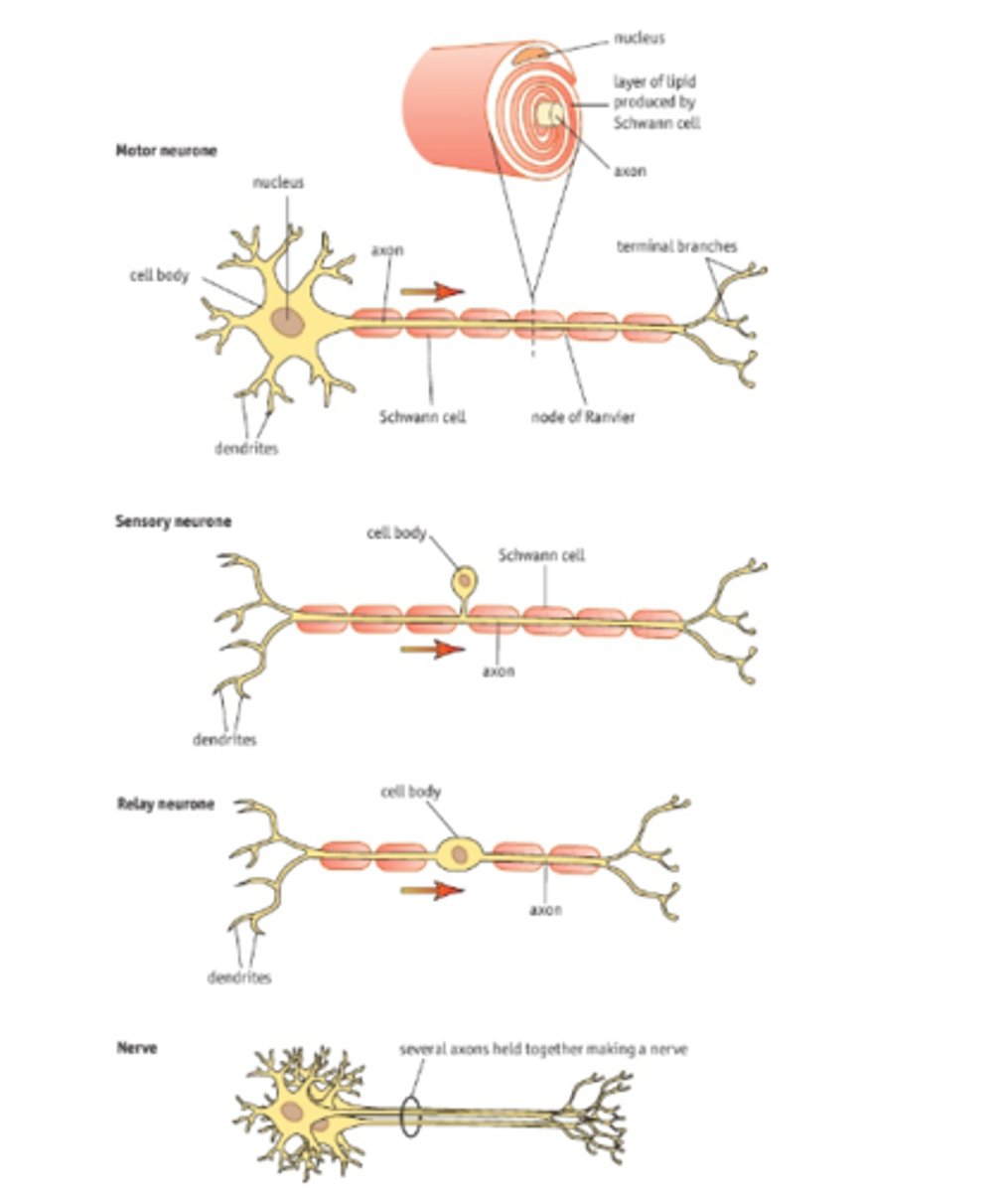
8.2 i) Understand how the nervous systems of organisms can cause effectors to respond to a stimulus.
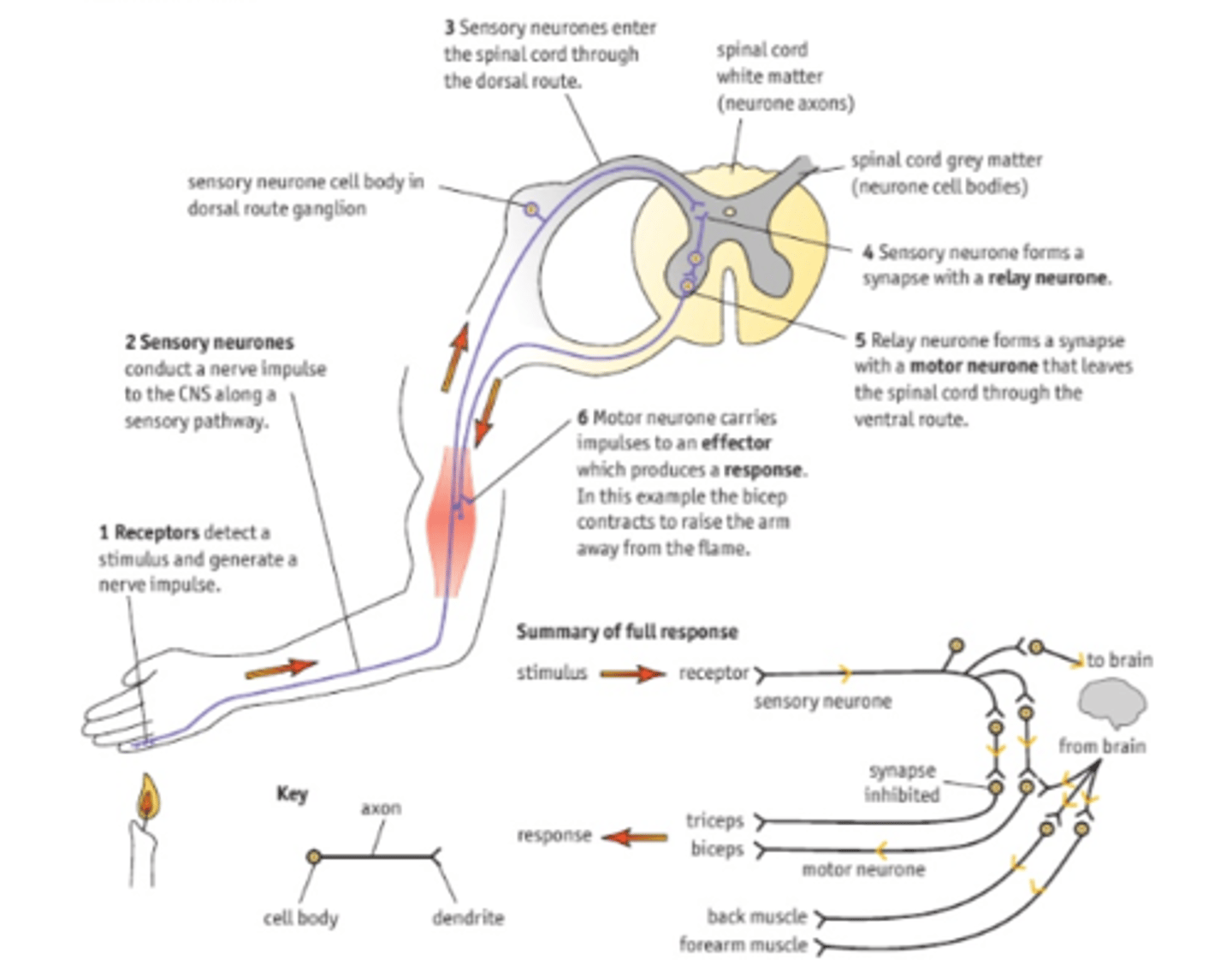
8.2 ii) Understand how the pupil dilates and contracts.
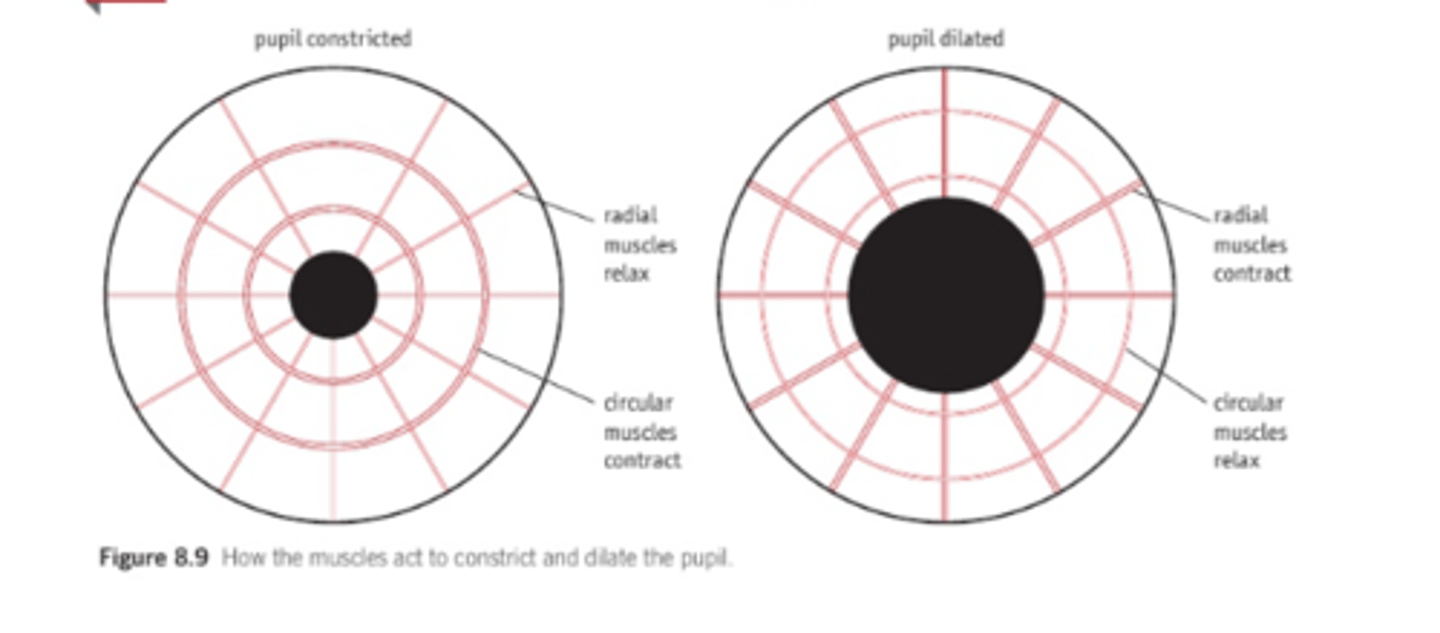
8.3 i) Understand how a nerve impulse (action potential) is conducted along an axon
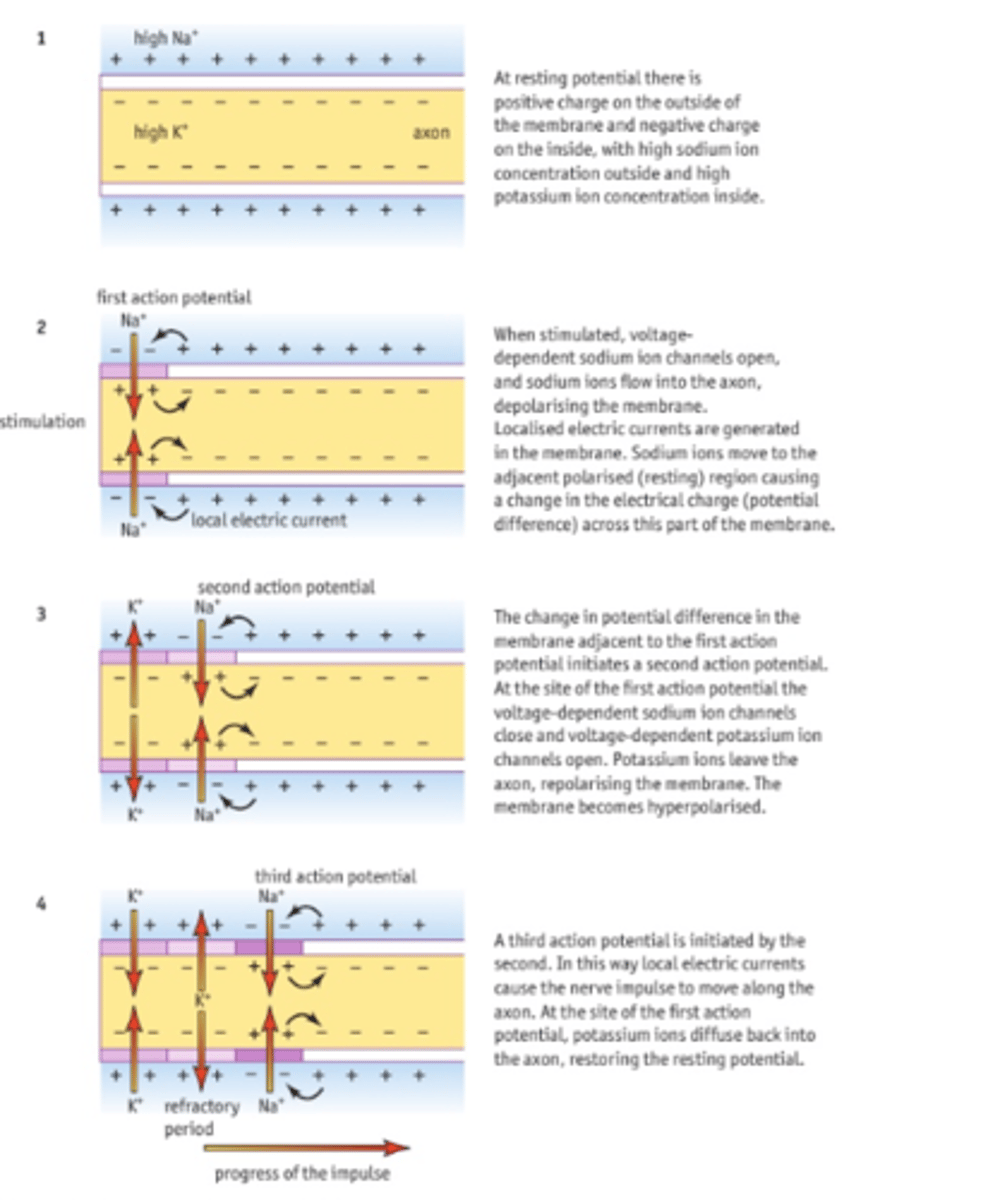
8.3 ii) How an action potential is triggered including changes in membrane permeability to sodium and potassium ions
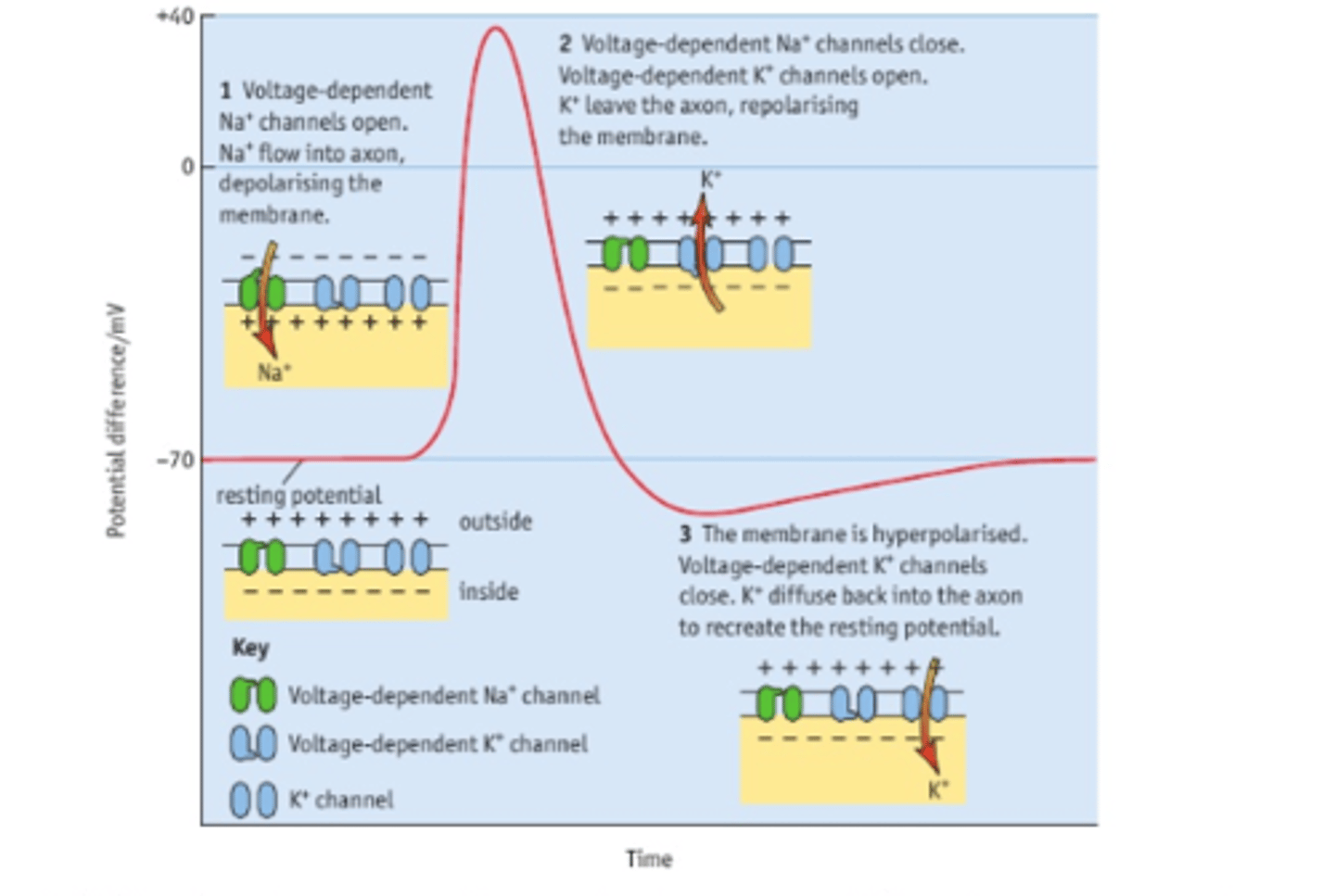
8.3 iii) The role of the myelination in saltatory conduction.
Schwann cells provide a fatty insulating layer to provide a quicker alternative path for impulses via saltatory conduction.

8.4 Know the structure and function of synapses in nerve impulse transmission, including the role of neurotransmitters, including acetylcholine.
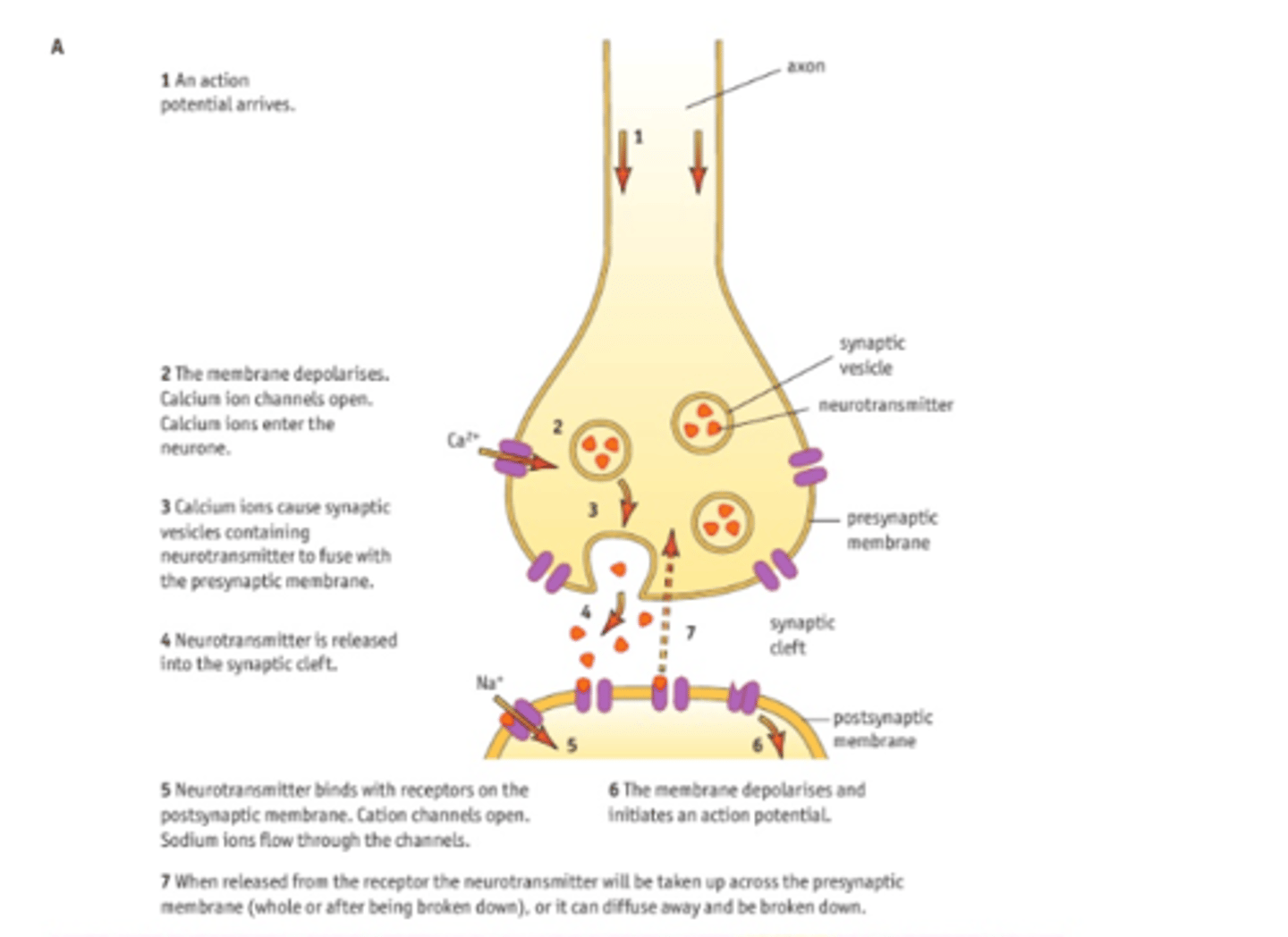
8.5 Understand how the nervous systems of organisms can detect stimuli with reference to rods in the retina of mammals, the roles of rhodopsin, opsin, retinal, sodium ions, cation channels and hyperpolarisation of rod cells in forming action potentials in the optic neurones.
In the dark,
Rhodopsin is regenerated
1) Some sodium channels are open, the rod cell is slightly depolarised
2) Synaptic response to depolarisation: Neurotransmitters are released at the inhibitory synapse.
3) The neurotransmitter prevents rod bipolar cell from depolarising.
4) The bipolar cell is at resting potential. it doesnt send any information to the brain via the optic nerve
In the light,
Rhodopsin is bleached, splits into retinal and opsin, that become trans.
1) Opsin causes sodium channels to close
2) Rod cell becomes hyperpolarised
3) Neurotransmitters are not released at the inhibitory synapse, so the bipolar cell is depolarised
4) An impulse is propagated to the ganglion cell, which sends information/action potentials to the brain through the optic nerve.
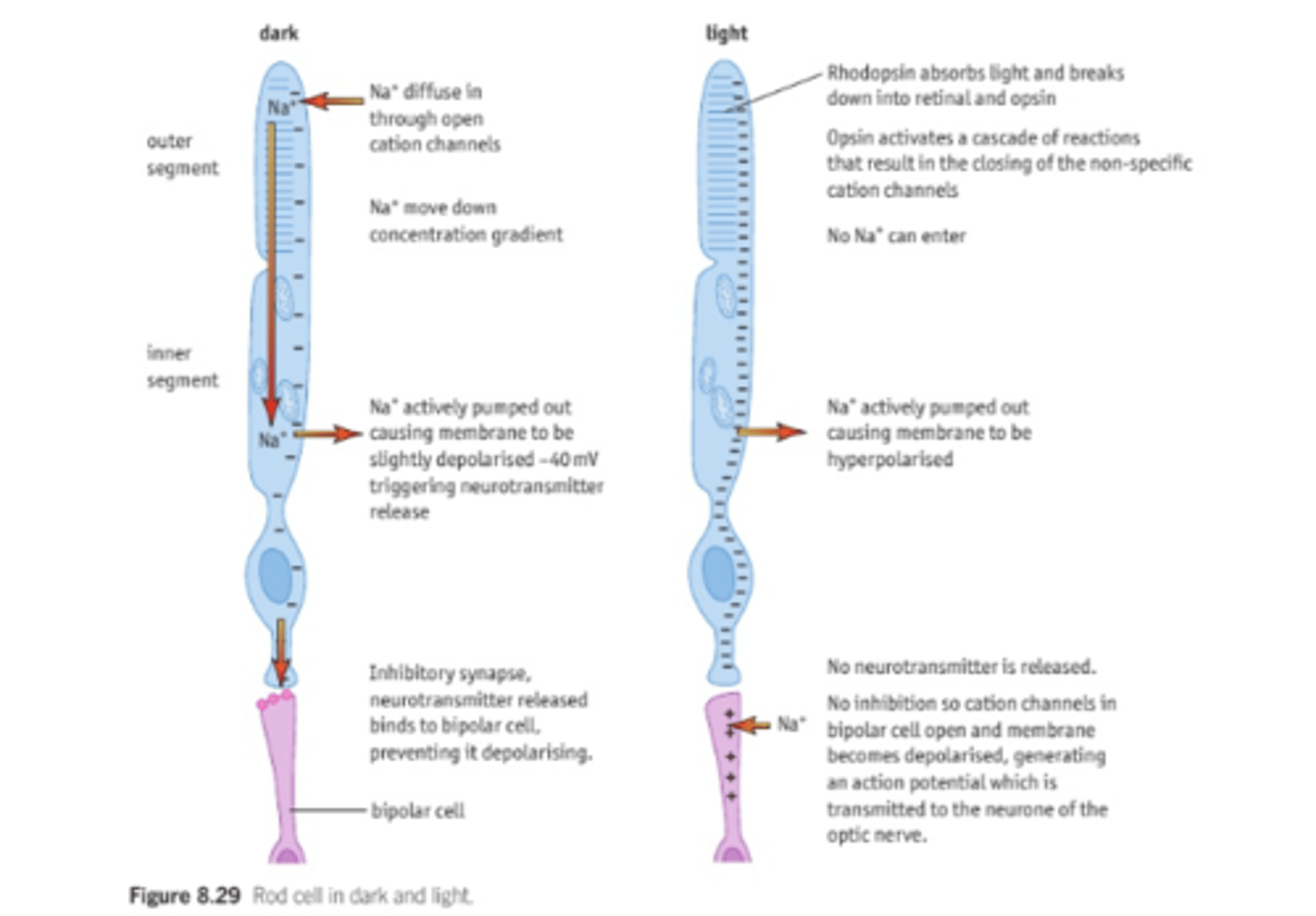
8.6 Understand how phytochrome and IAA bring about responses in plants to environmental cues, including their effects on transcription.
PR is converted into PFR in light, absorbing light at 660nm.
PFR breaks down into PR when it absorbs light at 730nm.
During the night, PFR converts to PR.
During the day, PR converts to PFR.
This means in longer days there is more PFR in the plant, which leads to a cellular response

how IAAs and phytochromes work:
IAA's cause cell elongation in the target cells furthest from light
They reduce pH in the cells which causes cells to elongate
PFR is the active form of PR:
when it has accumulated over the course of the day, during the darker time it can bind to transcription factors and cause transcription initiation factor complexes to be formed
This leads to gene expression where new mRNA can translate to new proteins that form new structures like flowers
8.7 Understand how co-ordination is brought about through nervous and hormonal control in animals.
Changes in the environment are detected by receptor cells.
Receptor cells send signals either by an action potential to the CNS or releasing a hormone into the blood.
The CNS sends an impulse to an effector, Or the hormone binds to receptors on target organs.
Nervous system: fast, short (until nerve impulses stop)
Endocrine (hormonal) system: slower, longer (until hormone is broken down)
8.8 Know the location and functions of the cerebral hemispheres, hypothalamus, cerebellum and medulla oblongata in the human brain.
Hypothalamus: control centre monitoring blood, maintains homeostasis
Cerebellum: coordination/movement/balance
Medulla oblongata: all involuntary actions; heart rate, breathing rate
Cerebral hemispheres: controls voluntary actions, thought, vision, speech, memory, problem solving

8.9 Understand how magnetic resonance imaging (MRI), functional magnetic resonance imaging (fMRI), positron emission tomography (PET) and computed tomography (CT) scans are used in medical diagnosis and the investigation of brain structure and function.
MRI: Can be used to see abnormal areas
Expensive, may interfere with pacemakers
fMRI: allows brain function to be studied in real time by detecting areas where oxyhaemoglobin absorbs fewer radio waves/where signals are absorbed less (i saw this in a mark scheme)
PET: shows accumulation of radioactive tracers in the brain. RADIOACTIVE!!!
CT: series of x ray images from different angles. RADIOACTIVE!!!
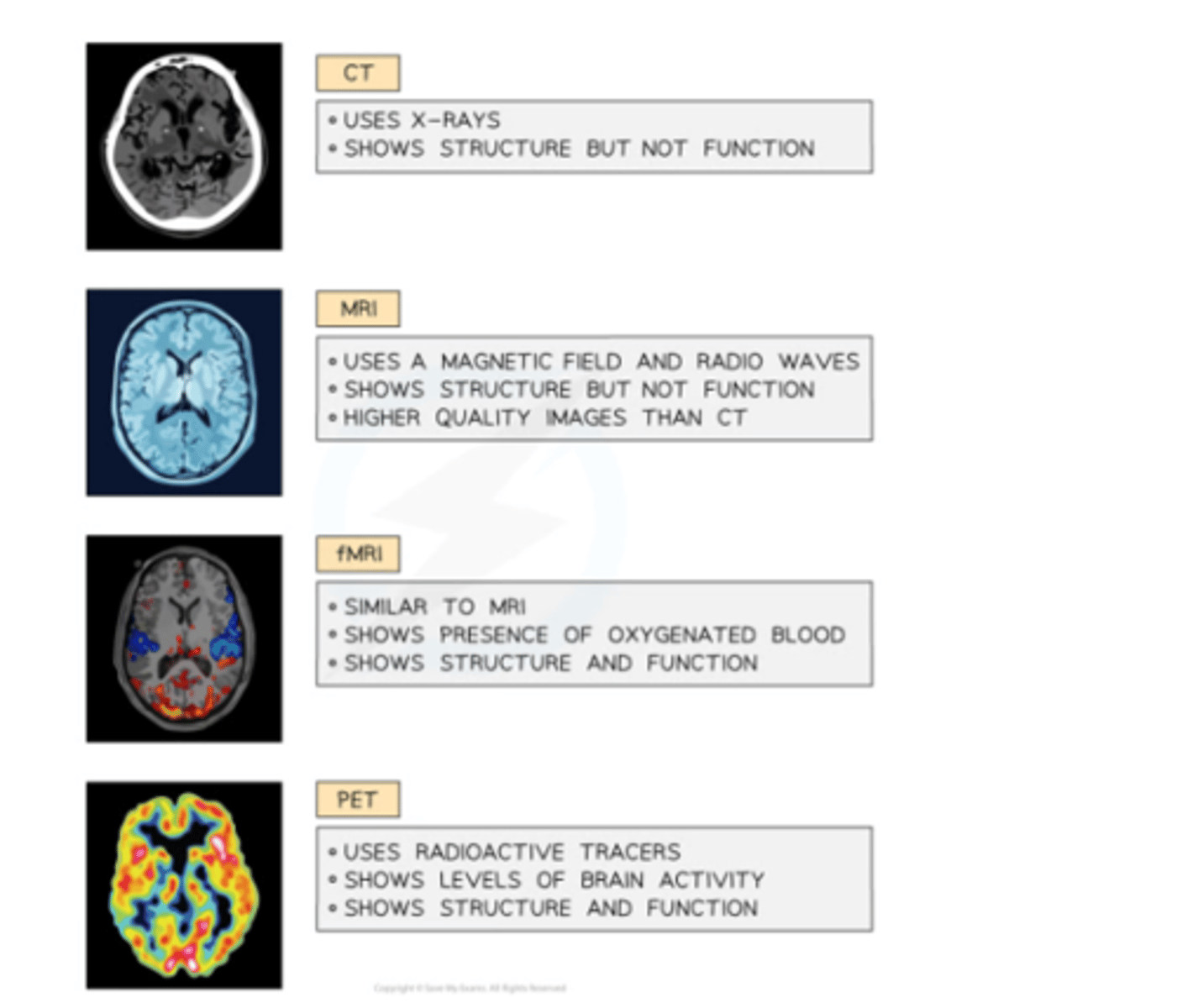
8.10 Understand what happens during the critical period so that mammals can develop their visual capacities to the full.
During the critical period, active synapses (to the target ocular cell columns in the visual cortex) are organised and increase in number/ (connections) are strengthened in the visual cortex when action potentials are transmitted through light stimulation of the retina.
Impulses travel from the retina to the thalamus, to the columns of cells in the visual cortex.
8.11 Understand the role animal models have played in the research into human brain development and function, including Hubel and Wiesel's experiments with monkeys and kittens.
Hubel and Wiesel deprived a monkey/kitten of light in one eye and after six months found that the retina responded to light but the visual cortex did not respond to any visual input.
i.e. VISUAL IMPAIRMENT
Same effect but temporary for animals deprived in one eye for 1 week.
Deprivation had no effect on adult animals
8.12 Be able to discuss moral and ethical issues relating to the use of animals in medical research from two ethical standpoints.
Animals cannot consent
Animal welfare is not in the best interest
Can cause harm/distress to animals, seen as cruel
However:
-People argue some animals cannot suffer/experience pleasure.
-Utilitarianism- maximising happiness in the world at the cost of the lives of animals, e.g. finding a cure to breast cancer at the cost of 250,000 mice
8.13 Understand how animals, including humans, can learn by habituation.
Upon a repeated stimulus, fewer calcium ions are released at the presynaptic membrane.
Less neurotransmitter is released, and an action potential is less likely to be generated.
The nerve impulse does not reach the effector organ and the animal does not respond to the stimulus.
For example, a repeated sound.
8.14 Understand how imbalances in certain, naturally occurring brain chemicals can contribute to ill health, including dopamine in Parkinson's disease and serotonin in depression, and to the development of new drugs.
•Lower dopamine levels= linked to parkinson's. (Fewer action potentials from less of the neurotransmitter leads to the symptoms.)
•Low levels of serotonin= linked to depression.
Examples of antidepressants
-SSRI's prevent uptake of serotonin, increasing serotonin levels in the synaptic cleft.
-TCAs increase serotonin directly
-MAOB inhibitors inhibit the enzymes that break down serotonin
Treatments for Parkinson's being researched
-Gene therapy
-Stem cell therapy
8.15 i) Understand the effects of drugs on synaptic transmissions, including the use of L-Dopa in the treatment of Parkinson's disease
L-dopa has a similar structure to dopamine. It can cross the blood brain barrier unlike dopamine.
L-dopa is given to a Parkinson's patient and it is converted into dopamine within the brain
8.15 ii) The action of MDMA in Ecstasy.
MDMA increases serotonin in the synaptic cleft:
•inhibits serotonin reuptake (binds to the responsible proteins
•increases serotonin release
8.16 Understand how the outcomes of genome sequencing projects are being used in the development of personalised medicine and the social, moral and ethical issues this raises
Knowing the sequence and structure of proteins involved in disease allows the development of drugs that target specific proteins.
How an individual may respond to treatments can be worked out using their genotype that can be sequenced.
•Patterns can be identified that can help to determine an individual's risk of disease.
•Preventative measures can be put in place.
Issues
-Only wealthier people may have access to personalised medicine.
-Personalised medicine may be used to discriminate, e.g. insurances, mortgages
-Knowing that there are no available treatments could cause distress to patients
8.17 Know how drugs can be produced using genetically modified organisms (plants, animals and microorganisms).
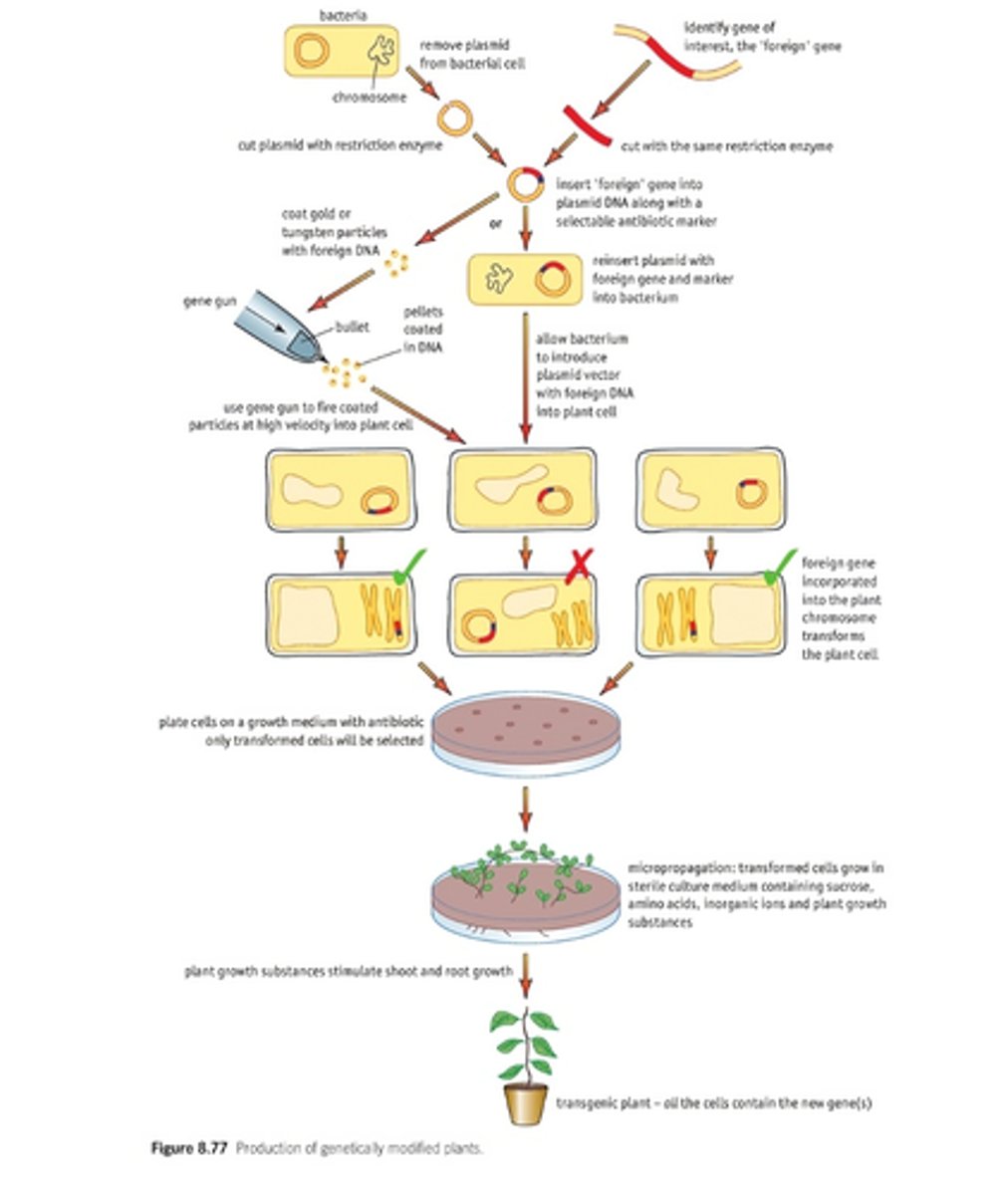
8.18 Understand the risks and benefits associated with the use of genetically modified organisms.
BENEFITS:
Increasing yield, quicker yield
More nutritious/tasty food
Disease resistant plants
RISKS:
Transfer of antibiotic-resistant genes to microbes
Formation of harmful products by new genes
Transfer of viruses from animals to humans
Transfer of genes to non-target species
8.19 Understand the methods used to investigate the contributions of nature and nurture to brain development, including evidence from the abilities of new-born babies, animal experiments, studies of individuals with damaged brain areas, twin studies and cross-cultural studies.
Animal experiments:
Nurture- controlling environmental factors when raising an animal
Nature- genetically modifying an animal to see how development is affected
Twin studies:
Nurture- identical twins can be studied in different environments
Nature- non-identical twins can be studied in the same environment
Cross cultural studies:
Nurture- large groups of children of the same age brought up in different cultures, i.e. environments
Brain damage studies:
A child with and without brain damage can be studied.
Nurture- if the brain damaged child develops the characteristic
Nature- if the brain damaged child does not develop the chosen characteristic
Newborn studies:
Nature- the newborn has not yet been exposed to the environment/learnt things so scientists can study the brain that has not affected by nurture
CORE PRACTICAL 18: Investigate habituation to a stimulus.
Equipment: snail, damp cotton bud, distilled water, chopping board, stopwatch
Method
1) Moisten chopping board, select a snail
2) tap between eye stalks and start timer simultaneously.
3) Record the time taken for the eye stalks to fully re-emerge.
4) Repeat until snail no longer retracts its eye stalks.
Graph: Number of touches against time to re-emerge
Statistics test: Spearman's Rank, compare with databook value to test hypothesis.